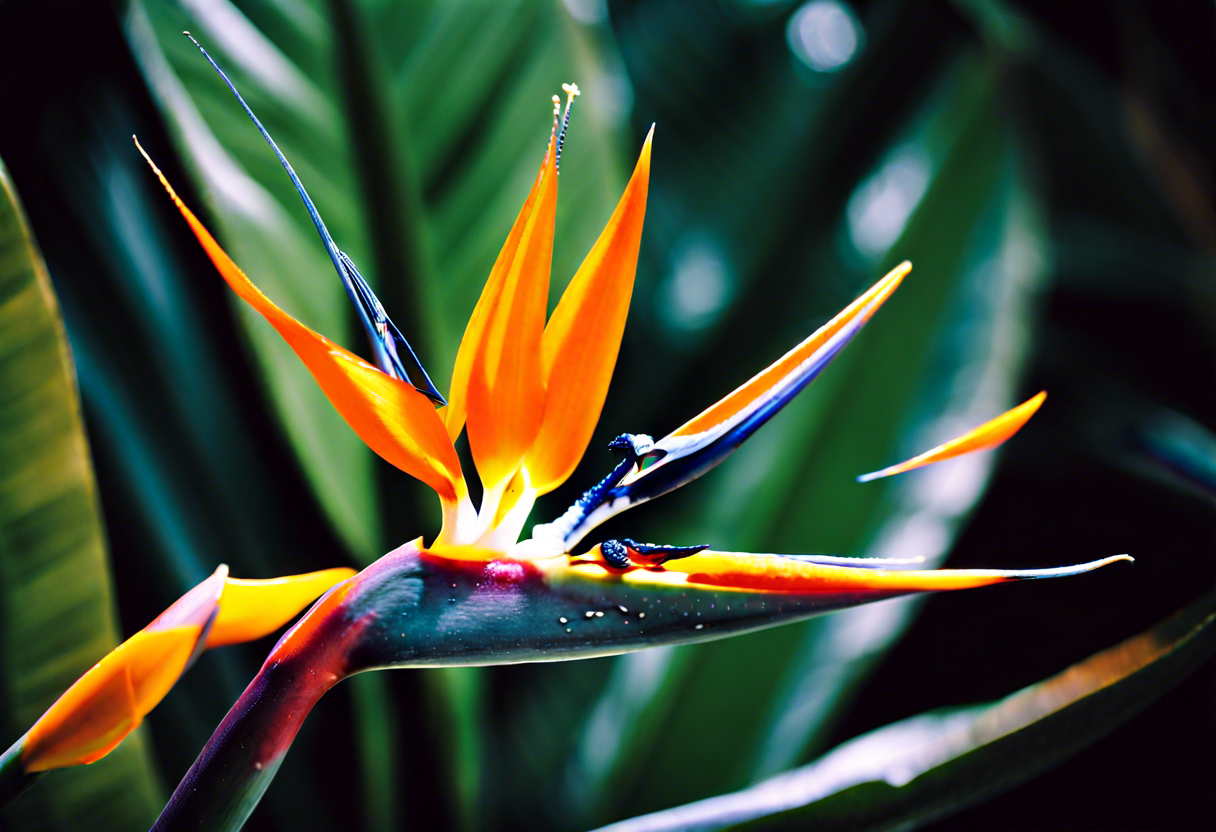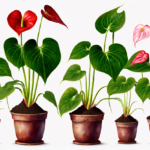Understanding the Bird of Paradise (Strelitzia reginae)
The Bird of Paradise (Strelitzia reginae) is a stunning flowering plant that belongs to the Strelitziaceae family. Native to South Africa, it is widely cultivated for its vibrant and exotic blooms, which resemble the plumage of tropical birds. This plant is also known as the Crane Flower or the Bird’s Tongue Flower due to its unique appearance.
The Bird of Paradise is a perennial plant that can reach a height of up to five feet. Its leaves are glossy and leathery, with a paddle-like shape that can grow up to 18 inches long. The plant produces large, striking flowers that stand out with their bright orange and blue petals. The flowers emerge from a boat-shaped bract, which adds to their charm and elegance.
When it comes to caring for the Bird of Paradise, it is important to recreate its natural habitat as closely as possible. This plant thrives in warm and humid climates, so it requires a well-drained soil mix that retains moisture without becoming waterlogged. It is best to use a mixture of peat moss, perlite, and coarse sand to provide the ideal growing conditions.
In terms of water requirements, the Bird of Paradise prefers regular watering but dislikes excessive moisture. It is crucial to avoid overwatering as it can lead to root rot and other issues. To ensure proper moisture levels, allow the top inch of soil to dry out between waterings. During the winter months, reduce watering frequency to prevent waterlogging and promote healthy growth.
Proper sunlight and temperature are vital for the optimal growth of the Bird of Paradise. This plant thrives in bright, indirect light and should be placed near a window that receives plenty of sunlight. However, direct sunlight can scorch the leaves, so it is best to provide partial shade during the peak summer months. The ideal temperature range for the Bird of Paradise is between 65°F and 70°F (18°C to 21°C). Avoid exposing the plant to temperatures below 50°F (10°C).
When it comes to pruning, the Bird of Paradise benefits from regular maintenance to encourage new growth and maintain its shape. Remove any dead or damaged leaves by cutting them off at the base. If the plant becomes too large or unruly, you can also trim back the stalks to control its size. Propagation of the Bird of Paradise can be done through division or by collecting and planting its seeds.
The Bird of Paradise (Strelitzia reginae) is a striking and exotic plant. By understanding its basic care requirements, you can provide a suitable environment for it to thrive. Remember to provide the right growing conditions, water and moisturize appropriately, offer proper sunlight and temperature, and practice regular pruning and propagation techniques. By doing so, you can enjoy the beauty and elegance of this remarkable plant.
Ideal Growing Conditions for Bird of Paradise Plants
When it comes to the Bird of Paradise (Strelitzia reginae), creating the ideal growing conditions is crucial for its overall health and vibrancy. This tropical plant, native to South Africa, is known for its stunning flowers and distinctive foliage. By following a few key guidelines, you can ensure that your Bird of Paradise thrives in your home or garden.
First and foremost, it is important to provide your Bird of Paradise with the right soil. Well-draining soil is essential for preventing root rot, which can be fatal to the plant. Ideally, you should use a mix of organic compost and coarse sand to ensure good drainage. This will help to prevent waterlogged soil and promote healthy root development.
Another critical factor for the optimal growth of Bird of Paradise plants is proper watering. These plants prefer to be kept moderately moist, but they do not tolerate soggy soil. Allow the top inch of soil to dry out before watering again, and be mindful not to overwater. It is better to underwater than to overwater, as the latter can lead to root rot and other problems.
Sunlight is another key requirement for the Bird of Paradise. These plants thrive in bright, indirect light. While they tolerate some shade, they will not flower as abundantly without enough light. Place your Bird of Paradise in a location where it can receive at least six hours of bright, filtered sunlight each day. If growing indoors, near a sunny window is often the best option.
In terms of temperature, Bird of Paradise plants prefer warm climates. They thrive in temperatures around 70-90°F (21-32°C). Ensure that your plant is protected from cold drafts and extremes in temperature. If you live in a colder climate, consider growing your Bird of Paradise in a container so you can bring it indoors during the winter months.
Routine pruning is essential for maintaining the health and appearance of your Bird of Paradise. Remove any dead, damaged, or yellowing leaves as needed. Additionally, trimming back excessive growth can help maintain the plant’s desired shape and size. Pruning should be done during the spring or early summer months.
Creating the ideal growing conditions for your Bird of Paradise plants involves providing well-draining soil, proper watering, ample sunlight, and suitable temperature. Routine pruning will also help keep the plant healthy and visually appealing. By following these guidelines, you can enjoy the striking beauty of the Bird of Paradise in your own home or garden.
Watering and Moisture Requirements for Bird of Paradise
The Bird of Paradise (Strelitzia reginae) is a tropical plant that requires specific watering and moisture conditions to thrive. Understanding these requirements is crucial for maintaining the health and beauty of this stunning plant.
1. Watering Frequency: Bird of Paradise plants prefer moist soil but are susceptible to root rot if overwatered. It is essential to find the right balance and avoid both underwatering and overwatering. Generally, watering once a week during the growing season and reducing frequency during winter is recommended. However, this may vary depending on factors such as climate, pot size, and soil type.
2. Proper Drainage: Ensuring good drainage is crucial for Bird of Paradise plants. They prefer well-draining soil to prevent waterlogged conditions. Using a potting mix that contains perlite or sand can help improve drainage. Additionally, make sure the pot has drainage holes to allow excess water to escape.
3. Watering Technique: When watering Bird of Paradise, it is best to thoroughly soak the soil until water drains from the bottom of the pot. This helps encourage deep root growth and prevents the accumulation of salts in the soil. Avoid shallow watering, as it encourages shallow root growth and makes the plant more vulnerable to drought stress.
4. Humidity: Bird of Paradise plants appreciate higher humidity levels. If you live in a dry climate or your home has low humidity, consider using a humidifier or placing a tray of water near the plant to increase moisture in the air. Misting the leaves occasionally can also provide a humidity boost.
5. Moisture Monitoring: Regularly check the moisture level of the soil by inserting a finger about an inch deep into the soil. If it feels dry, it’s time to water. If it feels moist, it’s best to wait before watering. Remember, it’s better to slightly underwater than overwater. The plant can tolerate short periods of drought but suffers from excessive moisture.
6. Avoiding Water Stagnation: To prevent water from pooling around the plant, ensure proper drainage in both indoor and outdoor settings. If cultivating Bird of Paradise outdoors, consider positioning it in an area with adequate slope to facilitate water runoff.
By understanding and implementing proper watering and moisture requirements, you can help your Bird of Paradise plant thrive and showcase its vibrant, tropical beauty to the fullest.
The Importance of Proper Sunlight and Temperature for Bird of Paradise
Providing proper sunlight and maintaining the right temperature are crucial factors in ensuring the healthy growth and development of Bird of Paradise (Strelitzia reginae) plants. These vibrant and exotic plants originate from South Africa and thrive in warm climates. By following the care guidelines below, you can create an ideal environment for your Bird of Paradise to flourish.
Sunlight Requirements:
Bird of Paradise plants require abundant sunlight to thrive. They prefer full sun or bright indirect light. Placing them by a south-facing window, where they can receive sunlight for at least 6 to 8 hours a day, is ideal. Lack of sufficient light may result in weak growth, fewer blooms, and elongated, leggy stems. In areas with intense sunlight or during hot summer months, partial shade during the hottest part of the day can prevent scorching of the leaves.
Temperature:
These tropical plants thrive in temperatures ranging from 65°F to 80°F (18°C to 27°C). They do not tolerate frost and are best suited for USDA hardiness zones 9 to 11. It is crucial to protect them from temperatures below 50°F (10°C) as it can cause damage to their foliage and overall health. If you live in a region with colder winters, it is recommended to grow Bird of Paradise plants in containers so they can be easily moved indoors during the colder months.
Providing Optimal Conditions:
In addition to sunlight and temperature, it is important to consider other factors when providing optimum conditions for your Bird of Paradise:
- Soil: These plants thrive in well-draining soil that is rich in organic matter. A mixture of loam, sand, and peat moss provides ideal conditions for healthy growth.
- Watering: Bird of Paradise plants prefer evenly moist soil. Water them thoroughly, allowing the top inch of soil to dry out between waterings. Overwatering can lead to root rot, while underwatering can cause the leaves to turn brown and wilt.
- Humidity: These tropical plants appreciate humid environments. If the air in your home is dry, you can increase humidity by placing the plant on a tray filled with pebbles and water. Mist the leaves occasionally to mimic the humidity of their natural habitat.
- Fertilizing: Regular fertilization during the growing season can promote vigorous growth and abundant blooms. Use a balanced, water-soluble fertilizer specifically designed for houseplants, following the instructions on the packaging.
By ensuring that your Bird of Paradise plants receive the right amount of sunlight, maintaining suitable temperatures, and providing optimal growing conditions, you can enjoy their stunning beauty and lush foliage year-round. With proper care, these captivating plants will undoubtedly be a vibrant addition to your indoor or outdoor garden.
Understanding the Bird of Paradise (Strelitzia reginae)
The Bird of Paradise (Strelitzia reginae) is a stunning tropical plant known for its exotic and vibrant flowers. Native to South Africa, it is a popular choice among garden enthusiasts and plant collectors worldwide. Its unique blooms resemble a bird in flight, hence its name.
This plant features long and stiff stalks with large, paddle-shaped leaves that can grow up to 6 feet in length. The leaves are a rich green color, providing an attractive backdrop for the flamboyant flowers that emerge from the stalks. The blossom itself is formed by an arrangement of three bright orange petals and three blue petals with a touch of white.
When it comes to growing Bird of Paradise plants, there are a few essential factors to consider. First and foremost, these plants thrive in warm climates and are best suited for USDA hardiness zones 9-11. In colder regions, they can be grown indoors or in greenhouses to protect them from frost. These plants prefer well-drained soil that is rich in organic matter.
Proper watering is crucial for the health of your Bird of Paradise. While they require regular watering to keep the soil consistently moist, it is important to avoid overwatering. This can lead to root rot and other issues. It is recommended to water the plant thoroughly, allowing the soil to dry slightly between waterings. During the winter months, reduce the frequency of watering.
In terms of sunlight and temperature, Bird of Paradise plants thrive in bright, indirect light. They require at least 4-6 hours of sunlight per day to promote healthy growth and vibrant blooms. However, direct sunlight for extended periods may cause leaf burn, so it’s best to provide them with some shade during the hottest part of the day. As for temperature, they prefer a range between 60-70°F (15-21°C) during the day and slightly cooler temperatures at night.
Pruning is an important aspect of Bird of Paradise care. Regular pruning helps maintain the plant’s shape and promotes healthy growth. Remove any dead, damaged, or yellowing leaves by cutting them back to the base of the plant. If you want to propagate your Bird of Paradise, division is the most common method. Divide mature plants during spring or early summer, ensuring each division has a healthy root system and several stems.
Bird of Paradise (Strelitzia reginae) is a striking tropical plant known for its bird-like flowers. Understanding its growing conditions, such as suitable sunlight, temperature, and watering requirements, is essential for keeping these plants healthy. Additionally, proper pruning and propagation techniques can help maintain their shape and expand your collection. these care practices will ensure your Bird of Paradise thrives and continues to delight with its vibrant blooms.
Conclusion
The Bird of Paradise (Strelitzia reginae) is a stunning tropical plant that can bring a touch of exotic beauty to any garden or indoor space. Understanding the unique characteristics and needs of this plant is key to successfully caring for it.
To provide the ideal growing conditions for Bird of Paradise plants, it is essential to choose a well-draining soil mixture that is rich in organic matter. This will ensure proper root development and prevent waterlogged conditions that could lead to root rot. Additionally, maintaining a consistent watering routine and avoiding overwatering will help keep the plant healthy.
Watering and moisture requirements for the Bird of Paradise are crucial. The plant prefers to be evenly moist, but not soggy. It is recommended to water the plant deeply and allow the top few inches of soil to dry out before watering again. This will prevent waterlogged roots and ensure proper hydration for the plant.
Proper sunlight and temperature are vital for the Bird of Paradise to thrive. This plant thrives in bright, indirect sunlight, making it suitable for both indoor and outdoor locations. It is important to protect the plant from direct sun, as this can scorch the leaves. Moreover, maintaining a temperature range of 60-70°F (15-21°C) is ideal for the Bird of Paradise. Avoid exposing it to cold drafts or extreme temperature fluctuations.
When it comes to pruning and propagation, the Bird of Paradise benefits from regular maintenance. Pruning is necessary to remove dead or damaged leaves, as well as to shape the plant. Propagation can be done through division or seed germination, with dividing the plant being the most common method.
By following the care guide for the Bird of Paradise (Strelitzia reginae), gardeners and plant enthusiasts can enjoy a thriving and visually stunning addition to their collection. Understanding the plant’s unique needs, providing the right growing conditions, and implementing proper watering, sunlight, and temperature practices are key to keeping this tropical beauty healthy and vibrant. With regular pruning and propagation, the Bird of Paradise can continue to thrive and grace gardens for years to come.


